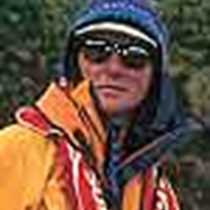Ushuaia, Argentina and the Drake Passage
As if out of nowhere they appear just off the decks of the National Geographic Endeavour. In a glistening flash and within the blink of an eye they magically appear all around us, sometimes in flocks numbering in the hundreds. As if from the deep blue depths, they transform from liquid to solid and alight, floating along effortlessly beside us. They rarely need to flap their wings, for as the wind's energy gives them loft their weight carries them forward. These petrels (who appear to walk on water as did St. Peter) become our constant companions, and we head southward accompanied by them in the Drake Passage.
This body of water (the Drake) is somewhat loosely defined, but technically it is the blustery, sometimes wild open ocean expanse dividing the temperate southern tip of South America and the icy confines of the Antarctic Peninsula. It is here that the pintado or "cape" petrels live and from where they obtain their food. We are heading in the same direction as the petrels, and we delight in watching their aerial antics.
We have incredibly calm conditions for such a notorious stretch of open ocean. It was the Drake, in fact, that kept early mariners from easily finding Antarctica (and exploiting its resources) even though they knew it must be there. Icebergs, for instance, had to come from a very large "southern continent." Much like the early mariners and in search of fabled riches, we will now only photograph. We sail on, entering the colder productive waters south of the Antarctic Convergence Zone. Soon we anticipate our first iceberg and our first glimpse of the famous icy continent.
The albatross numbers begin to wane, and southern fulmars and Antarctic prions appear. Even a few Antarctic petrels flutter about amongst the pintados; the former with their chocolate brown and white contrasting patterns are here, so experience tells us that we must be close! The sea water temperature drops from 5 degrees C to 0.5 degrees C and all within a day of Argentina we are biologically in Antarctica.
Today's photo is a bit of a game. Can you spot the pintado petrel camouflaged by the sparkling blue sea?
As if out of nowhere they appear just off the decks of the National Geographic Endeavour. In a glistening flash and within the blink of an eye they magically appear all around us, sometimes in flocks numbering in the hundreds. As if from the deep blue depths, they transform from liquid to solid and alight, floating along effortlessly beside us. They rarely need to flap their wings, for as the wind's energy gives them loft their weight carries them forward. These petrels (who appear to walk on water as did St. Peter) become our constant companions, and we head southward accompanied by them in the Drake Passage.
This body of water (the Drake) is somewhat loosely defined, but technically it is the blustery, sometimes wild open ocean expanse dividing the temperate southern tip of South America and the icy confines of the Antarctic Peninsula. It is here that the pintado or "cape" petrels live and from where they obtain their food. We are heading in the same direction as the petrels, and we delight in watching their aerial antics.
We have incredibly calm conditions for such a notorious stretch of open ocean. It was the Drake, in fact, that kept early mariners from easily finding Antarctica (and exploiting its resources) even though they knew it must be there. Icebergs, for instance, had to come from a very large "southern continent." Much like the early mariners and in search of fabled riches, we will now only photograph. We sail on, entering the colder productive waters south of the Antarctic Convergence Zone. Soon we anticipate our first iceberg and our first glimpse of the famous icy continent.
The albatross numbers begin to wane, and southern fulmars and Antarctic prions appear. Even a few Antarctic petrels flutter about amongst the pintados; the former with their chocolate brown and white contrasting patterns are here, so experience tells us that we must be close! The sea water temperature drops from 5 degrees C to 0.5 degrees C and all within a day of Argentina we are biologically in Antarctica.
Today's photo is a bit of a game. Can you spot the pintado petrel camouflaged by the sparkling blue sea?




